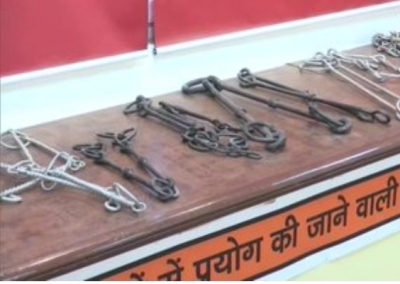UP set to become $1 trillion economy by 2029: CM Yogi
Uttar Pradesh Chief Minister Yogi Adityanath stated that the state is rapidly progressing toward becoming India’s largest economy.
Set up by the Uttar Pradesh prison department, this jail museum has a rich collection of mementos related to legendary inmates during the freedom movement.

Photo: IANS
This is a museum with a difference. Set up by the Uttar Pradesh prison department, this jail museum has a rich collection of mementos related to legendary inmates during the freedom movement, including India’s first Prime Minister Jawaharlal Nehru.
Though the museum was set up in March 2020, it remained closed for the public mainly due to the pandemic.
Advertisement
On display at the museum are chains, shackles, and fetters weighing over 30 kg, used to restrain the Kakori train robbery case heroes Ram Prasad Bismil, Ashfaqulla Khan, Thakur Roshan Singh, Rajendra Nath Lahri and Sachindranath Sanyal.
Advertisement
There is also a copy of the poetry penned by Bismil during his incarceration, besides the 1927 death warrants of Khan, Bismil, Lahiri, and Singh, in Urdu and Persian — all convicted in the Kakori case for waging war against the government, criminal conspiracy, and dacoity with murder.
Director General Prisons, Anand Kumar said: “The jail museum depicts the journey of jails since the 18th century.”
Bismil’s belongings, including books, bedsheet, comb, utensils, a pair of slippers, and a kurta used in jail, besides the container in which his mother sent him desi ghee that was allowed by the then jailer who was apparently sympathetic towards the revolutionaries, are among the notable exhibits.
The orders of the sentences of Ganesh Shanker Vidyarthi, who served terms in Lucknow, Hardoi, and Kanpur jails for taking part in the Home Rule movement, are on display, as is the order on Veer Chandra Singh.
Manindra Nath Banerjee, who had attacked a deputy superintendent of CID in Varanasi for executing his uncle Rajendra Nath Lahiri in the Kakori case, served 10 years’ rigorous imprisonment in Fatehgarh jail. His sentence order in English is in the collection.
The 95-year-old rope used for hanging prisoners awarded the death penalty is also on exhibit. It was used for hanging over 50 prisoners.
The hand flour grinder of stone, used by prisoners in 1888, is also on display. Its use in prisons was discontinued after independence.
Advertisement